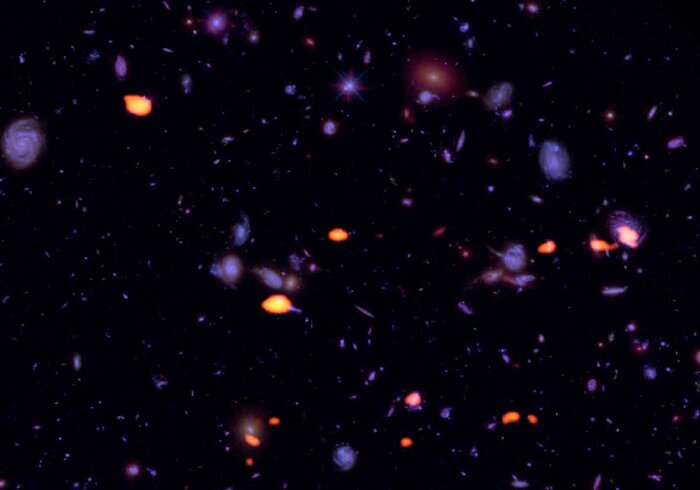New Insights into the ‘Golden Age’ of Galaxy Formation
Studies of a distant corner of the Universe, the Hubble Ultra Deep Field, made with the Atacama Large Millimeter Array (ALMA) have revealed distant galaxies rich in molecular gas. Their high gas content likely fueled the high rate of star formation during the “Golden Age” of galaxy formation 10 billion years ago. The discovery was made by international team of astronomers, including NOAO astronomer Mark Dickinson.
Credit:B. Saxton (NRAO/AUI/NSF); ALMA (ESO/NAOJ/NRAO); NASA/ESA Hubble
About the Image
| Id: | noaoann16019a |
| Type: | Observation |
| Release date: | Oct. 11, 2016 |
| Related announcements: | noaoann16019 |
| Size: | 2288 x 1600 px |
About the Object
| Name: | Hubble Ultra Deep Field |
| Constellation: | Fornax |
| Category: | Cosmology |
Wallpapers
Coordinates
| Position (RA): | 3 32 37.94 |
| Position (Dec): | -27° 46' 27.80" |
| Field of view: | 1.35 x 0.95 arcminutes |
| Orientation: | North is 0.0° right of vertical |
Colors & filters
| Band | Wave-length | Tele-scope |
|---|---|---|
| Optical V | 606 nm | Hubble Space Telescope ACS |
| Optical B | 435 nm | Hubble Space Telescope ACS |
| Optical I | 850 nm | Hubble Space Telescope ACS |
| Optical I | 814 nm | Hubble Space Telescope ACS |
| Optical i | 775 nm | Hubble Space Telescope ACS |
| Optical J | 1.25 μm | Hubble Space Telescope WFC3 |
| Infrared H | 1.6 μm | Hubble Space Telescope WFC3 |
| Infrared Z | 1.05 μm | Hubble Space Telescope WFC3 |
| Millimeter 231.2 GHz | 1.3 mm |
Atacama Large Millimeter/submillimeter Array
Band 6 |

